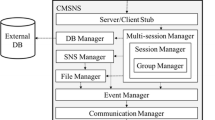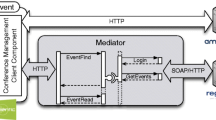Abstract
The development of collaborative multimedia applications today follows a vertical development approach, where each application is built on top of low-level network abstractions such as the socket interface. This stovepipe development process is a major inhibitor that drives up the cost of development and slows down the innovation pace of new generations of communication applications. In this paper, we propose a network communication broker (NCB) that provides a unified higher-level abstraction for the class of multimedia collaborative applications. We demonstrate how NCB encapsulates the complexity of network-level communication control and media delivery, and expedites the development of applications with various communication logics. We investigate the minimum necessary requirements for the NCB abstraction. We identify that the concept of user-level sessions involving multiple parties and multiple media, is critical to designing a reusable NCB to facilitate next-generation multimedia communications. Furthermore, the internal design of NCB decouples the user-level sessions from network-level sessions, so that the NCB framework can accommodate heterogeneous networks, and applications can be easily ported to new network environments. In addition, we demonstrate how the extensible and self-managing design of NCB supports dynamic adaptation in response to changes in network conditions and user requirements.










Similar content being viewed by others
References
Access Grid, http://www.accessgrid.org/
Aksit M, Choukair Z (2003) Dynamic, adaptive and reconfigurable systems overview and prospective vision. In Proceedings of the 23rd International Conference on Distributed Computing SystemsWorkshops (ICDCSW’03), May
Blair GS, Coulson G, Robin P, Papathomas M (1998) An architecture for next generation middleware, Middleware’98, September
Bond GW, Cheung E, Hal Purdy K, Zave P, Ramming JC (2004) An open architecture for next-generation telecommunication services. ACM Transactions on Internet Technology IV(1):83–123
Chen WK, Hiltunen MA, Schlichting RD (2001) Constructing adaptive software in distributed systems. In Proceedings of the 21st International Conference on Distributed Computing Systems (ICDCS-21), pp. 635–643, April
Deng Y, Sadjadi SM, Clarke P, Zhang C, Hristidis V, Rangaswami R, Prabakar N (2006) A communication virtual machine. The 30th Annual International Computer Software and Applications Conference (IEEE COMPSAC), September
Dey AK, Abowd GD (2000) The context toolkit: Aiding the development of context-aware applications. The 22nd International Conference on Software Engineering (ICSE), June
Fide S, Jenks SF (2007) A middleware approach for pipelining communications in clusters. Cluster Comput 10:409–424
Google, Google Talk. http://www.google.com/talk/
Handley M, Schulzrinne H, Schooler E, Rosenberg J (1999) SIP: session initiation protocol, RFC 2543, March
Hiltunen MA, Schlichting RD (1996) Adaptive distributed and fault-tolerant systems. International Journal of Computer Systems Science and Engineering 11:125–133
ITU-T Recommendation H.323v.4 “Packet-based multimedia communications systems”, November 2000
Jabber, http://www.jabber.org/
JAIN-SIP. https://jain-sip.dev.java.net/
Java Media Framework (JMF). http://java.sun.com/javase/technologies/desktop/media/jmf/
Juszczyk L, Dustdar S (2008) A middleware for service-oriented communication in mobile disaster response environments, 6th International Workshop on Middleware for Pervasive and Ad-Hoc Computing (MPAC). 9th ACM/IFIP/USENIX Middleware Conference 2008. December
Kephart JO, Chess DM (2003) The vision of autonomic computing. IEEE Computer 36:41–50
Kortuem G et al. (2001) When peer-to-peer comes face-to-face: collaborative peer-to-peer computing in mobile ad-hoc networks. In Proceedings of the 2001 International Conference on Peer-to-Peer Computing (P2P2001), August
Lennox J, Schulzrinne H (2003) A protocol for reliable decentralized conferencing”, ACM NOSSDAV
McKinley PK, Padmanabhan UI, Ancha N, Sadjadi SM (2003) Composable proxy services to support collaboration on the mobile internet. IEEE Transactions on Computers, 713–726, June
McKinley PK, Sadjadi M, Kasten EP, Cheng BHC (2004) Composing adaptive software. IEEE Computer, 56–64, July
Pereiral FMQ, Valente MTO, Bigonhal RS, Bigonhal MAS (2006) Arcademis: a framework for object oriented communication middleware development. Software: Practice and Experience 36(5):495–512
Polycom, http://www.polycom.com/
Radvision, http://www.radvision.com/
Rosenberg J, Weinberger J, Huitema C, Mahy R (2003) STUN — Simple Traversal of User Datagram Protocol (UDP) Through Network Address Translators (NATs), RFC 3489, March
Schmidt DC (1993) The ADAPTIVE communication environment: an object-oriented network programming toolkit for developing communication software. Concurrency: Practice and Experience 5(4):269–286
Schulzrinne H, Casner S, Frederick R, Jacobson V (2003) RTP: a transport protocol for real-time applications, RFC 3550, July
Skype Limited, Skype developer zone. https://developer.skype.com/
Sousa JP, Garlan D (2002) Aura: an architectural framework for user mobility in ubiquitous computing environments. In Proceedings of the third Working IEEE/IFIP Conference on Software Architecture, pp. 29–43
SUN, Java Telephony API, http://java.sun.com/products/jtapi/
The Parlay Group, Parlay/osa specifications, http://www.parlay.org/en/specifications/
van Renesse R, Birman KP, Hayden M, Vaysburd A, Karr D (1998) Building adaptive systems using Ensemble. Software Practice and Experience, vol. 28, August
Zhang C, Sadjadi M, Sun W, Rangaswami R, Deng Y (2006) A user-centric network communication broker for multimedia collaborative computing. Proceedings of the 2nd International Conference on Collaborative Computing, Atlanta, 2006
Zhang J, Liu L, Ramaswamy L, Zhang G, Pu C (2007) A utility-aware middleware architecture for decentralized group communication applications, ACM/IFIP/USENIX 8th International Middleware Conference (MIDDLEWARE-2007), November
Author information
Authors and Affiliations
Corresponding author
Rights and permissions
About this article
Cite this article
Zhang, C., Sadjadi, S.M., Sun, W. et al. A user-centric network communication broker for multimedia collaborative computing. Multimed Tools Appl 50, 335–357 (2010). https://doi.org/10.1007/s11042-009-0385-6
Published:
Issue Date:
DOI: https://doi.org/10.1007/s11042-009-0385-6




